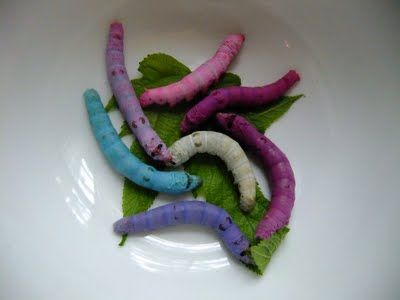Silkworms (Bombyx mori) are one of the most economically important insect species in the world, primarily due to their ability to produce silk. However, these organisms also exhibit a fascinating range of colour variations throughout their life stages, which raises the question: Why are silkworms different colours? The colour differences are not only a result of genetic factors but are also influenced by environmental conditions. This article delves into the genetic, environmental, and physiological mechanisms that govern the colour variations in silkworms.

One of the key contributors to the colour diversity in silkworms is the genetic framework that controls pigment synthesis and deposition in their bodies. Silkworms exhibit a variety of colours, including white, yellow, and brown, with genetic mutations playing a significant role in these variations. Understanding the underlying genetics is crucial for appreciating why these insects present such a broad spectrum of colourations.
The primary mechanism behind silkworm colouration is the presence of genetic mutations that control the expression of pigment-related genes. These mutations can produce different colour morphs, each with its own specific pigmentation profile:
White Silkworms: The most commonly observed colour is white, which is a result of a recessive genetic trait. White silkworms lack the ability to produce significant amounts of pigmentation, resulting in a lack of colour.
Yellow and Brown Silkworms: These silkworms produce pigments such as carotenoids and melanins, leading to yellow or brown coloration. Yellow silkworms typically possess a higher concentration of carotenoid pigments, while brown silkworms produce more melanin.
In some instances, sex-linked inheritance can contribute to colour differences. Sex-linked traits are carried on the X chromosome, and their expression can differ between males and females. However, in silkworms, sex-linked colour differences are less prominent compared to other species. Nonetheless, male and female silkworms may exhibit subtle colour variations based on their genetic makeup, particularly in certain strains.
The final colour of a silkworm is the result of complex gene interactions. The pigment production process involves various enzymes that are regulated by multiple genes. For example, some silkworm strains have mutations that disrupt the synthesis of specific enzymes involved in pigment production, leading to colour differences such as pale or muted hues in certain individuals.
While genetics plays a crucial role in determining the base colour of silkworms, environmental factors can also influence how these genetic traits are expressed. Factors such as temperature, diet, and developmental stages can all contribute to the appearance of silkworms.
Temperature is one of the most significant environmental factors influencing silkworm colouration. Research has shown that lower temperatures tend to enhance the expression of darker pigments, leading to more pronounced brown or black colours. Conversely, higher temperatures often result in lighter colours, with silkworms appearing more white or pale. This phenomenon occurs because temperature affects the enzymatic activity that controls pigment production, thereby altering the intensity of colouration.
The diet of silkworms, particularly their primary food source—mulberry leaves—can influence their growth and overall colouration. A nutrient-rich diet can contribute to the optimal expression of colour genes, while malnutrition or a lack of specific nutrients may lead to more subdued or pale colours. While diet does not directly alter the genetic foundation of colouration, it can influence the phenotype by affecting pigment synthesis and deposition.
The developmental stages of silkworms also play a role in colour variation. Silkworms undergo several instars (molting stages) before they become pupae. During these stages, their colour may change slightly, especially in certain strains where the larvae darken as they mature. The pigments produced during the larvae stage can become more concentrated, resulting in a noticeable change in colour as the silkworm progresses toward the cocoon stage.
While the colour of a silkworm does not directly influence the quality of the silk it produces, the colour of the silkworm can influence the appearance and marketability of the silk. White silkworms are traditionally preferred for silk production because their cocoons yield a bright, pure silk, which is highly valued in the textile industry. On the other hand, yellow or brown silkworms may produce silk with a unique colour, which can be used for creating fabrics with distinct textures or tones.
| Factor | Description |
|---|---|
| Genetics | Inherited mutations in pigment-related genes determine the primary colour of silkworms (e.g., white, yellow, or brown). |
| White Silkworms | Caused by a recessive genetic trait, resulting in a lack of pigment production, leading to white colouration. |
| Yellow/Brown Silkworms | Result from the expression of carotenoid or melanin-producing genes, leading to yellow or brown colouration. |
| Sex-linked Traits | Sex chromosomes may carry colour-related genes that cause subtle colour differences between male and female silkworms. |
| Temperature | Lower temperatures generally enhance darker pigmentation, while higher temperatures result in lighter colours. |
| Diet | A nutrient-rich diet supports optimal colour expression; malnutrition can lead to pale or muted colours. |
| Developmental Stages | Silkworms may change colour during molting stages, with some strains becoming darker as they mature. |
This table summarizes the key factors that contribute to the colour variations observed in silkworms. By combining insights from genetics, environmental factors, and the silkworm's life cycle, we can better understand the complex mechanisms behind these fascinating colour changes.
The colour differences in silkworms arise from a combination of genetic and environmental factors. While genetics lays the foundation by determining the types of pigments silkworms can produce, environmental conditions such as temperature, diet, and developmental stage can modify how these pigments are expressed. Understanding these factors not only sheds light on the biology of silkworms but also has practical implications for silkworm breeding and silk production.
animal tags: Bombycidae
We created this article in conjunction with AI technology, then made sure it was fact-checked and edited by a Animals Top editor.